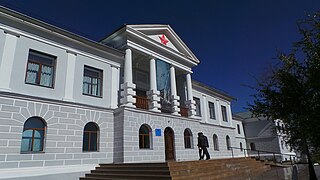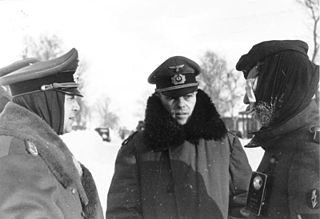
A prisoner of war (POW) is a person who is held captive by a belligerent power during or immediately after an armed conflict. The earliest recorded usage of the phrase "prisoner of war" dates back to 1610.

Giovanni Messe was an Italian field marshal and politician. In the Second World War, he was captured in Tunisia but made chief of staff of the Italian Co-belligerent Army after the armistice of September 1943. Later, he was an elected representative in the Italian Senate. He is considered by many to have been the best Italian general of the war.

Stalag XI-B and Stalag XI-D / 357 were two German World War II prisoner-of-war camps (Stammlager) located just to the east of the town of Fallingbostel in Lower Saxony, in north-western Germany. The camps housed Polish, French, Belgian, Soviet, Italian, British, Yugoslav, American, Canadian, New Zealander and other Allied POWs.

During World War II, the German Wehrmacht committed systematic war crimes, including massacres, mass rape, looting, the exploitation of forced labor, the murder of three million Soviet prisoners of war, and participated in the extermination of Jews. While the Nazi Party's own SS forces was the organization most responsible for the genocidal killing of the Holocaust, the regular armed forces of the Wehrmacht committed many war crimes of their own, particularly on the Eastern Front.

The Italian participation on the Eastern Front represented the military intervention of the Kingdom of Italy in the Operation Barbarossa, launched by Nazi Germany against the Soviet Union in 1941. The commitment to actively take part in the German offensive was decided by Benito Mussolini a few months before the beginning of the operation, when he became aware of Adolf Hitler's intention to invade, but it was confirmed only in the morning of 22 June 1941, as soon as the Italian dictator was informed that same day the German armies had invaded the Soviet Union.

Stalag IV-B was one of the largest prisoner-of-war camps in Germany during World War II. Stalag is an abbreviation of the German Stammlager. It was located 8 km (5.0 mi) north-east of the town of Mühlberg in the Prussian Province of Saxony, just east of the Elbe river and about 30 mi (48 km) north of Dresden. From 1944 to 1945 it belonged to the Province of Halle-Merseburg. Now, the area is in Brandenburg. A sub-camp, sometimes identified as Stalag IV-B/Z,Stalag 304 or Stalag IV-H was located at Zeithain, 10 km (6.2 mi) to the south in Saxony.

By the end of World War II, the number of Romanian prisoners of war in the Soviet Union was significant. Up to 100,000 Romanian soldiers were disarmed and taken prisoner by the Red Army after the Royal coup d'état of August 23, 1944, when Romania switched its alliance from the Axis Powers to the Allies. Before that date, almost 165,000 Romanian soldiers were reported missing, with most of them assumed to be POWs. Soviet authorities generally used prisoners of war as a work force in various labor camps.

After World War II there were from 560,000 to 760,000 Japanese personnel in the Soviet Union and Mongolia interned to work in labor camps as POWs. Of them, it is estimated that between 60,000 and 347,000 died in captivity.

Soviet prisoners of war (POWs) held by Nazi Germany and primarily in the custody of the German Army, were starved and subjected to deadly conditions. Of nearly six million that were captured, around 3 million died during their imprisonment, largely in 1941. Soviet Jews, commissars, Asians, and female combatants were systematically targeted for execution, while many other Soviet prisoners were shot for being wounded, ill, or unable to keep up with forced marches. Soviet prisoners of war were subjected to forced labor under conditions worse than civilian forced laborers or prisoners of war from other countries. More than 100,000 were transferred to Nazi concentration camps, where they were treated worse than other prisoners. Nearly a million Soviet prisoners of war volunteered to serve as auxiliaries to the German military; others joined the SS. Collaborators were essential to the German war effort as well as to the Holocaust in Eastern Europe.

During World War II, the Italian Expeditionary Corps in Russia was a corps-sized expeditionary unit of the Regio Esercito that fought on the Eastern Front. In July 1942 the CSIR entered the newly formed Italian Army in Russia as XXXV Army Corps.

The Italian Army in Russia was an army-sized unit of the Regio Esercito which fought on the Eastern Front during World War II between July 1942 and April 1943. The ARMIR was also known as the 8th Italian Army and initially had 235,000 soldiers. The bulk of this force was destroyed by the Soviet Red Army at the Battle of Stalingrad, after which Mussolini withdrew the remnants from Russia to the West.

Richard Ruoff was a general in the Wehrmacht of Nazi Germany during World War II. He commanded the 4th Panzer Army and the 17th Army on the Eastern Front.
There were two waves of the Finnish prisoners of war in the Soviet Union during World War II: POWs during the Winter War and the Continuation War.

Approximately three million German prisoners of war were captured by the Soviet Union during World War II, most of them during the great advances of the Red Army in the last year of the war. The POWs were employed as forced labor in the Soviet wartime economy and post-war reconstruction. By 1950 almost all surviving POWs had been released, with the last prisoner returning from the USSR in 1956. According to Soviet records 381,067 German Wehrmacht POWs died in NKVD camps. A commission set up by the West German government found that 3,060,000 German military personnel were taken prisoner by the USSR and that 1,094,250 died in captivity. According to German historian Rüdiger Overmans ca. 3,000,000 POWs were taken by the USSR; he put the "maximum" number of German POW deaths in Soviet hands at 1.0 million. Based on his research, Overmans believes that the deaths of 363,000 POWs in Soviet captivity can be confirmed by the files of Deutsche Dienststelle (WASt), and additionally maintains that "It seems entirely plausible, while not provable, that 700,000 German military personnel listed as missing actually died in Soviet custody."
Benvenuto "Nuto" Revelli was an Italian essayist and partisan.

During World War II, it was estimated that between 35,000 and 50,000 members of the Imperial Japanese Armed Forces surrendered to Allied servicemembers prior to the end of World War II in Asia in August 1945. Also, Soviet troops seized and imprisoned more than half a million Japanese troops and civilians in China and other places. The number of Japanese soldiers, sailors, marines, and airmen who surrendered was limited by the Japanese military indoctrinating its personnel to fight to the death, Allied combat personnel often being unwilling to take prisoners, and many Japanese soldiers believing that those who surrendered would be killed by their captors.

Soviet prisoners of war in Finland during World War II were captured in two Soviet-Finnish conflicts of that period: the Winter War and the Continuation War. The Finns took about 5,700 POWs during the Winter War, and due to the short length of the war they survived relatively well. However, during the Continuation War the Finns took 64,000 POWs, of whom almost 30 percent died.

Hebertshausen shooting range was a shooting range at Dachau concentration camp, located two kilometres north of the Dachau main camp for SS guards that used Soviet live prisoners of war as targets. It was built in 1937-38 as an expansion to Dachau concentration camp. Between 1941 and 1942, more than 4,000 Soviet prisoners were murdered on the site. These were mainly officers, communist officials, and Jews. The victims were “singled out” according to ideological and racist criteria by Gestapo Einsatzkommandos in the POW camps of the military districts of Munich, Nuremberg, Stuttgart, Wiesbaden and Salzburg. After World War II, American troops assumed control of the site and continued to use it as a firing range. It is now a memorial to Nazi victims.
The Russian People's Labour Party, or Russian National Labour Party, was a collaborationist organisation, formed by the administration of Oflag XIII-B POW camp from the prisoned Soviet Russian members of the Red Army in 1941. All "party" activities were overseen by German counter-intelligence (Abwehr).
















